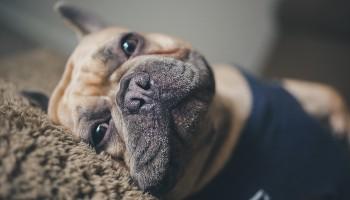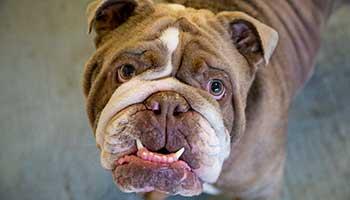What health issues do flat-faced pets suffer from?
Most pet owners hope for a long and healthy life for their pets but sadly, some animals are not so lucky. Brachycephalic (flat-faced) animals face a much greater risk of developing serious and painful health problems compared to other animals. Some of these need lifelong medical attention and care which can be deeply distressing and expensive, with significant vet bills and great emotional costs for both owners and pets.
If you own or are considering buying a flat-faced pet, it's important that you are aware of their common health issues. Make sure you pay great attention to your pet's health.
Breathing problems
Brachycephalic Obstructive Airway Syndrome (BOAS) is the clinical term used to describe the impact of the shortened heads of brachycephalic animals on the passage of air. These features impact flat-faced animals' ability to breathe.
Breathing difficulties can be extremely distressing for animals as it means every breath takes effort. The animal may feel like they're suffocating. They may also be unable to sleep properly as a result.
Signs include
- Snorting or snoring
- Sleeping or lying in odd positions
- Propping their mouths open with toys in order to try to sleep more comfortably
- Struggling to breathe during exercise and even collapsing
It's very important to monitor flat-faced animals' breathing during exercise and hot weather, as they struggle to cool themselves down by panting.
Dogs aren't the only ones at risk. Cats such as Persians are also more prone to BOAS and its impacts on quality of life.
Getting a full diagnosis may be lengthy, costly and intrusive as most testing for BOAS will require general anaesthetic. In many cases, surgery is required to try and ensure a reasonable quality of life. This is by no means an easy solution and carries some risks to the animal. This should always be considered as a potential outcome when buying a flat-faced pet, as most of these breeds will experience some degree of upper airway obstruction.
Surgeries may include
- Removal of cartilage in the nose
- Reduction of soft palate
- Removal of significant tissue causing larynx collapse (voice box)
- Tonsil removal
Weight management is also recommended as a preventative course of treatment to reduce breathing issues linked with breathing difficulties.
Dental problems
As one of the most common health issues in animals, dental issues are a concern for all pet owners. However, according to research by the Royal Veterinary College, flat-faced breeds overall had 1.25 times the risk of dental disease compared with breeds with medium-length skulls. This is due to the difference in the shape of the skull, meaning teeth are placed differently. A flat-faced animal has the same amount of teeth as an animal with a longer snout, but nowhere for them to go. This results in overcrowding and could cause periodontal disease (infections of the gums). Sadly, this teeth condition has been normalised and is expected with flat-faced animals.
Dental problems can cause severe pain for animals, lasting weeks or months in serious cases. Sadly, they can also lead to other serious health problems such as heart disease.
Signs of dental problems include
- Swollen or bleeding gums
- Bad breath
- Difficulty eating
- Weight loss
Rabbit breeds such as Netherland Dwarfs and lionheads also suffer the same. They have a huge risk of dental disease and mouth injuries. Their teeth grow continuously, and because of their skull shape, their teeth can’t wear down. They should naturally be able to keep them at a healthy length and shape. This can cause painful dental abscesses. In worst cases, teeth grow into their tear ducts, making it look as though they’re crying.
Treatments can include
- Orthodontic procedures on teeth placement (for younger animals)
- Tooth extraction (for periodontal disease)
- Use of dental care products and treatments
Eye conditions
Due to their flat faces and shallow eye sockets, flat-faced animals are prone to a condition called Brachycephalic Ocular Syndrome (BOS). This is common among the smaller breeds such as pugs and French bulldogs, due to their prominent/bulging eyes and shallow eye sockets.
Animals with eye conditions may experience
- Excessively widened eyelids
- Can't blink properly resulting in dry eyes
- Eye trauma such as ulceration
- Damage to the surface of the eye impacting sight
- Abnormal tear production
- Entropion (where eyelids fold inwards and scratch the eyeball)
- Ultimately loss of sight and even loss of an eye/s is not uncommon in these breeds
Symptoms include
- Excessive blinking/squinting
- Sensitive to light
- Rubbing at eyes with a paw
- Changes in behaviour
- Redness or clouding of the eye
- Eye watering
Treatments include
- Pain management and eye drops to treat the underlying problems as well as any secondary infection. In many cases, the medications are required long term
- For severe ulcers and entropion, surgical procedures may be required
Skin issues
Due to some breeds' features like skin folds and wrinkles, flat-faced animals are more vulnerable to skin conditions such as infections and irritation. These can cause a great deal of discomfort for any animal.
Flat-faced pets are at higher risk of allergic skin disease, making them more prone to infections and chronic itching. This can be highly frustrating and irritating for the animal. It's possible to manage most skin allergies after a programme of tests and treatments. In most cases lifelong medications are required. Although modern medications are safer than older options, they're a lot more costly.
Spinal deformities
Some dogs, such as those with coiled or short tails, are at higher risk of spinal deformities. Their genes cause the abnormal formation of the vertebrae in both the tail region and spinal column.
Some dogs may experience a gradual decline in their health due to symptoms of spinal issues, while others may experience a rapid decline. While some dogs may live with the symptoms without worrying progression, others might lose their ability to walk with paralysis of the back legs. They might also experience incontinence.
Symptoms include
- Wobbliness
- Pain
- Weak back legs and signs of muscle wastage
- Difference in walking
Support our flat-faced campaign
We want to protect future generations of animals from these debilitating issues that arise from selective breeding. You can help us by encouraging the UK Government to take action. You can also support us by spreading the word about the campaign on Facebook, Twitter and Instagram using #SaveOurBreath.




